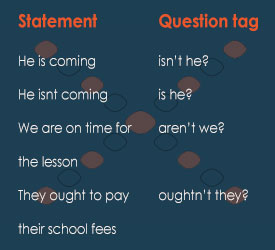Grammar and language use; Question tags
Question tags have been given that name because they are attached or tagged to statements.
Study the statements and question tags in the following examples.
What similarities and differences can you observe between the statement and the question tag in each sentence?

Note that:
- There is usually a verb in the statements and in the question tags.
- The verb in the statements is repeated in the same tense in the question tags.
- There is a negative (not) attached to the auxiliary verb and shortened to (n’t) either in the statement or in the question tag.
- A negative statement will have a positive question tag.
- A positive statement will have a negative question tag.
- In the question tag, the verb comes before the subject.
- In some sentences, a negative statement will have a positive question tag and a negative statement will follow.
- Likewise, a positive statement will have a negative question tag and will be followed by a positive statement.
Examine the use of question tags in the following four examples.
1. You will see her tomorrow, won’t you? Yes I will.
2. He knows the answer, doesn’t he? Yes he does.
3. Mary won’t agree, will she? No she won’t.
4. Halima has always been the best pupil in the class, hasn’t she? Yes she has.
